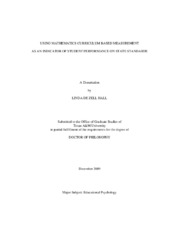| dc.description.abstract | Math skills are essential to daily life, impacting a person?s ability to function at
home, work, and in the community. Although reading has been the focus in recent years,
many students struggle in math. The inability to master math calculation and problem
solving has contributed to the rising incidence of student failure, referrals for special
education evaluations, and dropout rates. Studies have shown that curriculum based
measurement (CBM) is a well-established tool for formative assessment, and could
potentially be used for other purposes such as a prediction of state standards test scores,
however to date there are limited validity studies between mathematics CBM and
standard-based assessment. This research examined a brief assessment that reported to
be aligned to national curriculum standards in order to predict student performance on
state standards-based mathematics curriculum, identify students at-risk of failure, and
plan instruction. Evidence was gathered on the System to Enhance Educational
Performance Grade 3 Focal Mathematics Assessment Instrument (STEEP3M) as a
formative, universal screener. Using a sample of 337 students and 22 instructional staff,
four qualities of the STEEP3M were examined: a) internal consistency and criterion
related validity (concurrent); b) screening students for a multi-tiered decision-making
process; c) utility for instructional planning and intervention recommendations; and d)
efficiency of administration, scoring, and reporting results which were the basis of the
four research questions for this study. Several optimized solutions were generated from
Receiver Operator Curve (ROC) statistical analysis; however none demonstrated that the
STEEP3M maximized either sensitivity or specificity. In semi-structured interviews teachers reported that they would consider using the STEEP3M, however only as a part
of a decision-making rubric along with other measures. Further, teachers indicated that
lessons are developed before the school year starts, more in response to the sequence of
the state standards than to students? needs. While the STEEP3M was sufficiently long
enough for high-stakes or criterion-referenced decisions, this study found that the test
does not provide sufficient diagnostic information for multi-tiered decision-making for
intervention or instructional planning. Although practical and efficient to administer, the
conclusions of this study show the test does not provide sufficient information on the
content domain and does not accurately classify students in need of assistance. | en |


